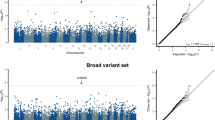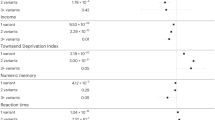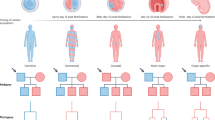Abstract
COL4A1-related disorders are characterized by a higher incidence of cerebral hemorrhage than other hereditary cerebral small vessel diseases. Accumulating data have shown broad phenotypic variations, and extracerebral hemorrhages have been linked to these disorders. Moreover, the coexistence of neural tumors has been described. Here, we report a Japanese family with a novel COL4A1 variant, including a patient with recurrent epistaxis and glioblastoma.
Similar content being viewed by others
COL4A1 encodes the α1 chain of type IV collagen, which consists of six types of α chains and forms the basic framework of the basement membrane. Mutated COL4A1 disrupts the basic structure of cerebral small vessels via a dominant-negative effect or haploinsufficiency, which results in autosomal-dominant cerebral small-vessel disease1,2. Approximately 60% of patients with COL4A1-related disorders present with diffuse white matter lesions, 50% with microbleeds, and 10–30% with hemorrhagic stroke3,4. The high incidence of intracerebral hemorrhage illustrates the clinical differences from other hereditary cerebral small-vessel diseases, such as cerebral autosomal dominant arteriopathy with subcortical infarcts and leukoencephalopathy (CADASIL), cerebral autosomal recessive arteriopathy with subcortical infarcts and leukoencephalopathy (CARASIL), and hereditary endotheliopathy, retinopathy, nephropathy, and stroke (HERNS)3. To date, more than 350 patients and 70 pathogenic and likely pathogenic variants have been reported5. The phenotypic spectrum of COL4A1-related disorders has been expanding, and accumulating data have shown that extracerebral hemorrhages may also occur4. Moreover, the coexistence of neural tumors has been observed6. Here, we report a Japanese family with hereditary cerebral small-vessel disease with a novel missense variant in COL4A1, including a patient who presented with recurrent epistaxis and glioblastoma.
The index patient was a 38-year-old Japanese man (Fig. 1a, patient II-1). His psychomotor development was uneventful. Multiple members of his family had a neuropsychiatric history: his mother was affected by epilepsy and juvenile dementia; his sister was affected by epilepsy, juvenile stroke, and depression; and his brother was affected by juvenile stroke. At age 5, he was admitted to a hospital due to recurrent vertigo, which disappeared within several weeks. He used to have a chronic headache without aura, nausea, and vomiting. The headache started in his early teens and disappeared by age 30. He also had a history of left scleritis.
a Pedigree chart of the family. The arrow indicates the index patient. b Diffuse white matter lesions on FLAIR imaging. c Porencephalic enlargement of the left ventricle. d Scattered microbleeds on T2* imaging. e Left cerebellar atrophy with a cleft on FLAIR imaging. f Abnormal hyperintensity in the superior frontal gyrus on DWI, which corresponds to the mild hyperintensity in b. g Sanger sequencing results of the identified variant: upper panel, index patient; lower panel, control.
At age 38, he developed spasms in his right upper limb, which became generalized, and he lost consciousness. He was diagnosed with epilepsy and treated with levetiracetam and lacosamide, which markedly reduced the frequency of seizures. Brain MRI revealed bilateral white matter lesions and cerebellar abnormalities. At approximately the same time, the patient began to experience spontaneous epistaxis. Bleeding often occurred more than three times a day but could be stopped by the compression of the nasal wings; thus, he did not seek medical care for this condition. The bleeding events were apparently not associated with the seizures. He was referred to Tokushima University Hospital due to white matter lesions, epilepsy, and a complicated neurological family history that suggested hereditary small-vessel disease.
On examination, he was 189 cm tall and 87 kg in weight and had a funnel chest. He had mild hypertension. He presented with horizontal gaze nystagmus, mild spasticity in his left lower limb, and exaggerated left patellar and Achilles tendon reflexes. Otherwise, he did not have neurological abnormalities. Brain MRI demonstrated diffuse bilateral hyperintensity in the white matter and porencephalic enlargement of the left ventricle on fluid-attenuated inversion recovery (FLAIR) imaging (Fig. 1b, c) and scattered microhemorrhages on T2*-weighted imaging (Fig. 1d). At the infratentorial level, moderate hypoplasia of the left cerebellar hemisphere with a cleft reaching the fourth ventricle was observed (Fig. 1e). Hyperintensity in the left superior frontal gyrus was noted on FLAIR (Fig. 1d) and diffusion-weighted images (Fig. 1f), which was thought to be a secondary change following epilepsy. MR angiography showed no evidence of cerebral aneurysm. Blood testing showed mildly decreased hemoglobin (11.2 mg/dl) and mildly increased CK (301 U/l) levels, but the other indicators were normal. Urinalysis showed microscopic hematuria. Abdominal echocardiography revealed simple cysts in both kidneys. Ophthalmic examination showed mild cataracts, but tortuous retinal arteries and retinal hemorrhages were not observed.
The genetic study was approved by the ethics committee of Tokushima University, and the patients provided written informed consent. Genomic DNA (gDNA) was extracted from the peripheral lymphocytes. gDNA libraries were prepared using SureSelect Human All Exon V6 (Agilent Technologies, Santa Clara, CA). Sequencing was performed on 100-bp paired-end reads using a HiSeq2000 sequencer (Illumina, San Diego, CA). The reads were aligned to the human reference genome using Burrows–Wheeler Aligner software7. Variants were identified using GATK software8 and annotated using wANNOVAR9. All of the reported genomic locations were in GRCh37/hg19. Exome sequencing revealed a heterozygous missense variant in COL4A1 (NM_001845.6:c.3797G>T, p.Gly1266Val), which was validated via Sanger sequencing (Fig. 1g). The variant was not registered in dbSNP Build 153, Genome Aggregation Database v2.1.1, or an in-house exome database consisting of 491 patients with various neurological diseases. The variant was predicted to be likely deleterious by PolyPhen-2 (http://genetics.bwh.harvard.edu/pph2/), pathogenic by Mutation Taster (http://www.mutationtaster.org/), and deleterious by SIFT (http://sift.jcvi.org/). The CADD Phred score (https://cadd.gs.washington.edu/) for the variant was 24.8. The variant changed conserved glycine residues within the Gly-Xaa-Yaa repeat of the collagen triple-helical domain, which is the most common substitution associated with COL4A1-related disorders10. Moreover, a different amino acid substitution at the same position, p.Gly1266Arg, was previously reported11. According to the 2015 guidelines of the American College of Medical Genetics and Genomics12, the variant was classified as being likely pathogenic. We confirmed that the patient’s mother and sister harbored the same variant via Sanger sequencing. Moreover, we obtained brain MRI scans of these two patients, which revealed diffuse white matter lesions and multiple microbleeds on FLAIR and T2*-weighted images in both (Fig. 2a–d). Taken together, we diagnosed the patient and his two affected family members with COL4A1-related disorders.
a, b Brain MRI of the patient’s mother (a, FLIAR image; b, T2* image). Note that the patient’s mother showed moderate brain atrophy. c, d Brain MRI of the patient’s sister (c FLAIR image; d T2* image). e, f MRI characteristics of the glioblastoma in the index patient (e FLAIR image; f gadolinium-enhanced T1-weighted image). g The resected brain tissue stained with hematoxylin and eosin. Note the marked hypercellularity, nuclear atypia, microvascular proliferation, and necrosis. Bar = 100 µm.
The epistaxis spontaneously subsided approximately 4 months after onset. Nine months after the onset of epilepsy, he developed weakness in his right upper and lower limbs. Brain MRI revealed a mass in the left frontal lobe, which was where FLAIR and DWI hyperintensity had been observed in the previous examination. The mass expanded aggressively and showed a ring-like enhancing pattern (Fig. 2e, f). The patient subsequently underwent resection followed by radiotherapy and temozolomide. Upon pathological examination of the resected tissue, a diagnosis of glioblastoma (WHO grade IV) was made. Genetic analysis of the specimen showed a mutation in the core promoter region of TERT (NC_000005.9(NM_198253.2):c.-146C>T) and wild-type IDH1 R132 and IDH2 R172, which is a typical pattern observed in grade IV glioblastoma13.
Broad phenotypes have been linked to COL4A1-related disorders, ranging from catastrophic hemorrhage in the uterus to adult-onset hemorrhagic/ischemic stroke, epilepsy, and even clinically asymptomatic patients4,5. A wide intrafamilial variation in clinical symptoms has also been confirmed11. In this family with p.Gly1266Val, epilepsy, white-matter disease, microbleeds, and juvenile ischemic stroke were the core clinical features, and each phenotype occurred in multiple individuals. However, porencephaly, juvenile dementia, and depression occurred only in unique individuals. Moreover, the cardinal neurological features associated with the previously reported variant p.Gly1266Arg include infantile hemiplegia and microcephaly11, which were not observed in this family, supporting the previous finding of poor genotype–phenotype correlations in COL4A1-related disorders5.
Cerebral hemorrhage is an important feature in COL4A1-related disorders. Perinatal cerebral hemorrhage may lead to porencephaly1,14, which has been observed in approximately 20% of patients4. Of note, the index patient presented with unilateral cerebellar hypoplasia and a cleft, which were attributable to perinatal cerebellar hemorrhage15, in addition to a porencephalic enlargement of the left ventricle. Published data have indicated that hemorrhage may be observed in extracerebral organs. To date, six patients with retinal hemorrhages have been reported4. Moreover, a 30-week-old fetus was affected by hemorrhages in the thymus, liver, and adrenal glands16, and a 9-year-old boy developed diffuse pulmonary hemorrhage17. Interestingly, the index patient presented with recurrent epistaxis, which has not been reported in association with the disease. Given the expanding spectrum of the disease and the reports of extracerebral hemorrhages, we hypothesize that it might be a novel phenotype.
The development of glioblastoma in the index patient was an unexpected event. The seizure was initially considered to be a part of the symptoms of COL4A1-related disorders; we retrospectively found that the seizure and hyperintensity in the left superior frontal gyrus were more likely due to glioblastoma. Two cases of meningioma and one case of neuroblastoma have been reported in patients with COL4A1-related disorders6, but the authors mentioned that such common neural tumors were unlikely to be a phenotype of the disease. Consistent with this notion, glioblastoma is a common tumor in adulthood. Moreover, the presence of the TERT promoter mutation may support the notion that tumorigenesis in our patient was independent of the COL4A1 variant. Nevertheless, a network analysis found that the upregulation of COL4A1 could influence the development of glioblastoma multiforme (GBM)18, and the introduction of miR-29b into the GBM cell line exerted anticancer effects by inhibiting the expression of extracellular matrix genes, including COL4A119. Considering these facts, it might be possible that the COL4A1 variant in the index patient affected the development of glioblastoma.
In summary, we identified a two-generation family with a novel COL4A1 variant. The index patient presented with recurrent epistaxis, which might be associated with the disease, which can present as extracerebral hemorrhages. Moreover, the development of glioblastoma in the patient might be related to the COL4A1 variant, and further research is warranted to determine the causal relationship between COL4A1-related disorders and neural tumors.
HGV database
The relevant data from this Data Report are hosted at the Human Genome Variation Database at https://doi.org/10.6084/m9.figshare.hgv.3006.
References
Gould, D. B. et al. Mutations in Col4a1 cause perinatal cerebral hemorrhage and porencephaly. Science 308, 1167–1171 (2005).
Lemmens, R. et al. Novel COL4A1 mutations cause cerebral small vessel disease by haploinsufficiency. Hum. Mol. Genet. 22, 391–397 (2013).
Lanfranconi, S. & Markus, H. S. COL4A1 mutations as a monogenic cause of cerebral small vessel disease: a systematic review. Stroke 41, e513–e518 (2010).
Rannikmae, K. et al. Beyond the brain: systematic review of extracerebral phenotypes associated with monogenic cerebral small vessel disease. Stroke 51, 3007–3017 (2020).
Zagaglia, S. et al. Neurologic phenotypes associated with COL4A1/2 mutations: expanding the spectrum of disease. Neurology 91, e2078–e2088 (2018).
Meuwissen, M. E. et al. The expanding phenotype of COL4A1 and COL4A2 mutations: clinical data on 13 newly identified families and a review of the literature. Genet. Med. 17, 843–853 (2015).
Li, H. & Durbin, R. Fast and accurate short read alignment with Burrows-Wheeler transform. Bioinformatics 25, 1754–1760 (2009).
McKenna, A. et al. The Genome Analysis Toolkit: a MapReduce framework for analyzing next-generation DNA sequencing data. Genome Res. 20, 1297–1303 (2010).
Wang, K., Li, M. & Hakonarson, H. ANNOVAR: functional annotation of genetic variants from high-throughput sequencing data. Nucleic Acids Res. 38, e164 (2010).
Jeanne, M. & Gould, D. B. Genotype-phenotype correlations in pathology caused by collagen type IV alpha 1 and 2 mutations. Matrix Biol. 57-58, 29–44 (2017).
Shah, S. et al. Childhood presentation of COL4A1 mutations. Dev. Med. Child Neurol. 54, 569–574 (2012).
Richards, S. et al. Standards and guidelines for the interpretation of sequence variants: a joint consensus recommendation of the American College of Medical Genetics and Genomics and the Association for Molecular Pathology. Genet. Med. 17, 405–424 (2015).
Nonoguchi, N. et al. TERT promoter mutations in primary and secondary glioblastomas. Acta Neuropathol. 126, 931–937 (2013).
Itai, T. et al. Prenatal clinical manifestations in individuals with COL4A1/2 variants. J. Med. Genet. 0, 1–9 (2020).
Bosemani, T. et al. Congenital abnormalities of the posterior fossa. Radiographics 35, 200–220 (2015).
Garel, C. et al. Fetal intracerebral hemorrhage and COL4A1 mutation: promise and uncertainty. Ultrasound Obstet. Gynecol. 41, 228–230 (2013).
Abe, Y. et al. A severe pulmonary complication in a patient with COL4A1-related disorder: a case report. Eur. J. Med. Genet. 60, 169–171 (2017).
Kunkle, B. W., Yoo, C. & Roy, D. Reverse engineering of modified genes by Bayesian network analysis defines molecular determinants critical to the development of glioblastoma. PLoS ONE 8, e64140 (2013).
Shin, J. et al. Restoration of miR-29b exerts anti-cancer effects on glioblastoma. Cancer Cell Int. 17, 104 (2017).
Acknowledgements
We would like to acknowledge the Kansai Molecular Diagnosis Network for CNS tumors for the genetic study of the resected brain tumor.
Author information
Authors and Affiliations
Corresponding author
Ethics declarations
Conflict of interest
The authors declare no competing of interests.
Additional information
Publisher’s note Springer Nature remains neutral with regard to jurisdictional claims in published maps and institutional affiliations.
Rights and permissions
Open Access This article is licensed under a Creative Commons Attribution 4.0 International License, which permits use, sharing, adaptation, distribution and reproduction in any medium or format, as long as you give appropriate credit to the original author(s) and the source, provide a link to the Creative Commons license, and indicate if changes were made. The images or other third party material in this article are included in the article’s Creative Commons license, unless indicated otherwise in a credit line to the material. If material is not included in the article’s Creative Commons license and your intended use is not permitted by statutory regulation or exceeds the permitted use, you will need to obtain permission directly from the copyright holder. To view a copy of this license, visit http://creativecommons.org/licenses/by/4.0/.
About this article
Cite this article
Muto, K., Miyamoto, R., Terasawa, Y. et al. A novel COL4A1 variant associated with recurrent epistaxis and glioblastoma. Hum Genome Var 8, 18 (2021). https://doi.org/10.1038/s41439-021-00150-0
Received:
Revised:
Accepted:
Published:
DOI: https://doi.org/10.1038/s41439-021-00150-0
This article is cited by
-
Integrative rare disease biomedical profile based network supporting drug repurposing or repositioning, a case study of glioblastoma
Orphanet Journal of Rare Diseases (2023)





